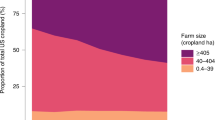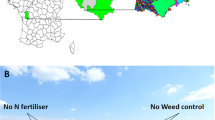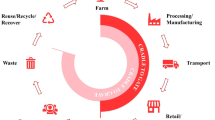Abstract
Escalating production costs, heavy reliance on non-renewable resources, reduced biodiversity, water contamination, chemical residues in food, soil degradation and health risks to farm workers handling pesticides all bring into question the sustainability of conventional farming systems1,2,3,4. It has been claimed5,6, however, that organic farming systems are less efficient, pose greater health risks and produce half the yields of conventional farming systems. Nevertheless, organic farming became one of the fastest growing segments of US and European agriculture during the 1990s7,8. Integrated farming, using a combination of organic and conventional techniques, has been successfully adopted on a wide scale in Europe9. Here we report the sustainability of organic, conventional and integrated apple production systems in Washington State from 1994 to 1999. All three systems gave similar apple yields. The organic and integrated systems had higher soil quality and potentially lower negative environmental impact than the conventional system. When compared with the conventional and integrated systems, the organic system produced sweeter and less tart apples, higher profitability and greater energy efficiency. Our data indicate that the organic system ranked first in environmental and economic sustainability, the integrated system second and the conventional system last.
This is a preview of subscription content, access via your institution
Access options
Subscribe to this journal
Receive 51 print issues and online access
$199.00 per year
only $3.90 per issue
Buy this article
- Purchase on Springer Link
- Instant access to full article PDF
Prices may be subject to local taxes which are calculated during checkout


Similar content being viewed by others
References
Matson, P. A., Parton, W. J., Power, A. G. & Swift, M. J. Agricultural intensification and ecosystem properties. Science277, 504–509 (1997).
Drinkwater, L. E., Wagoner, P. & Sarrantonio, M. Legume-based cropping systems have reduced carbon and nitrogen losses. Nature396, 262–265 (1998).
Tillman, D. Global environmental impacts of agricultural expansion: the need for sustainable and efficient practices. Proc. Natl Acad. Sci. USA96, 5995–6000 (1999).
Zhu, Y. et al. Genetic diversity and disease control in rice. Nature406, 718–722 (2000).
Avery, D. in Fearing Food: Risk, Health and Environment (eds Morris, J. & Bate, R.) 3–18 (Butterworth-Heinemann, Oxford, 1999).
Trewavas, A. Much food, many problems. Nature402, 231–232 (1999).
Greene, C. U. S. Organic agriculture gaining ground. Agric. Outlook270, 9–14 (2000).
Hamm, U. & Michelsen, J. in IFOAM 2000—The World Grows Organic. Proc. 13th Int. IFOAM Scientific Conf. (eds Alfoldi, T., Lockeretz, W. & Niggli, U.) 507–510 (IOS, Zurich, 2000).
Sansavini, S. Integrated fruit production in Europe: Research and strategies for a sustainable industry. Sci. Hort.68, 25–36 (1997).
Reganold, J. Farming's organic future. New Sci.122, 49–52 (1989).
Barrett, G. W. & Odum, E. P. The twenty-first century: The world at carrying capacity. BioScience50, 363–368 (2000).
Reganold, J. P., Papendick, R. I. & Parr, J. F. Sustainable agriculture. Sci. Am.262, 112–120 (1990).
Goodland, R. & Daly, H. Environmental sustainability: Universal and nonnegotiable. Ecol. Appl.6, 1002–1017 (1997).
Costanza, R. et al. The values of the world's ecosystem services and natural capital. Nature387, 253–260 (1997).
Naveh, Z. The total human ecosystem: Integrating ecology and economics. BioScience50, 357–361 (2000).
Merwin, I. A. & Pritts, M. P. Are modern fruit production systems sustainable? HortTechnology3, 128–136 (1993).
FAO Crop Production Statistics Web site [online], (cited 3 April 2001) 〈http://apps.fao.org/page/collections?subset=agriculture) (2001).
USDA National Agricultural Statistics Service Agricultural Statistics 1999 IX-17–IX-19 (US Government Printing Office, Washington DC, 1999).
Glover, J. D., Reganold, J. P. & Andrews, P. K. Systematic method for rating soil quality of conventional, organic, and integrated apple orchards in Washington State. Agric. Ecosystem Env.80, 29–45 (2000).
Doran, J. W. & Parkin, T. B. in Defining Soil Quality for a Sustainable Environment (eds Doran, J. W., Coleman, D. C., Bezdicek, D. F. & Stewart, B. A.) 3–21 (Soil Sci. Soc. Am., Madison, Wisconsin, 1994).
Brady, N. C. & Weil, R. R. The Nature and Properties of Soils 12th edn 468–469 (Prentice Hall, Upper Saddle River, New Jersey, 1999).
Dow, A. I. Critical Nutrient Ranges for Northwest Crops (West. Reg. Ext. Pub. 43, Oregon State University Cooperative Extension Service, Corvallis, 1980).
Gavlak, R. G., Horneck, D. A. & Miller, R. O. Plant, Soil and Water Reference Methods for the Western Region (West. Reg. Ext. Pub. 125, Univ. Alaska Cooperative Extension Service, Fairbanks, 1994).
Bechtel, L., Barritt, B., Dilley, M. & Hinman, H. Economic Analysis of Apple Orchard Management Systems with Three Varieties in Central Washington (Washington State Univ. Research Bulletin XB1032, Pullman, 1995).
Reed, N. in 125 thAnnual Report of the Secretary of the State Horticultural Society of Michigan (ed. Hull, J. Jr) 68–78 (Mich. State Hort. Soc., East Lansing, 1995).
Revised Code of Washington (RCW). Title 15. Chapter 15. 17. Standards of Grades and Packs (West Publishing, St Paul, 1998).
Apple Maturity Program Handbook (Apple Maturity Program, Wenatchee, Washington, 1986).
Kovach, J., Petzoldt, C., Degni, J. & Tette, J. A Method to Measure the Environmental Impact of Pesticides (New York's Food and Life Sciences Bulletin No. 139, Cornell Univ., Ithaca, 1992).
Leach, G. Energy and Food Production 71–77 (IPC Science and Technology Press, Guildford, UK, 1976).
Funt, R. C. in Handbook of Energy Utilization in Agriculture (ed. Pimentel, D.) 235–246 (CRC, Boca Raton, Florida, 1980).
Acknowledgements
We thank A. and E. Dolph for the use of their farm. We acknowledge funding from the USDA Agricultural Systems Program. We thank D. Fahy, D. Granatstein, L. Klein, S. Leach, C. Litzinger, A. O'Rourke, A. Palmer, R. Papendick, P. Salant, S. Sansavini and T. Schotzko for comments on drafts of this manuscript, and R. Alldredge, S. Drake, M. Fauci, J. Fellman, S. Mattinson, J. Powers, N. Reed, R. Rupp and K. Weller for technical assistance.
Author information
Authors and Affiliations
Corresponding author
Supplementary information

Figure 1.
Fruit size of apples from three production systems. Differences between values in a year followed by different letters are significant at the 0.05 level (LSD). (GIF 8.23 KB)

Figure 2.
Size distribution of apples in 1998 and 1999 from three production systems. The difference between the organic and conventional fruit size distributions resulted in an average 20% reduction in organic fruit value. (GIF 7 KB)

Figure 3.
Trunk cross-sectional area (TCSA) of apple trees grown in three production systems. No differences in growth were detected in any year between treatments at the 0.05 level (LSD). (GIF 6.28 KB)

Figure 4.
The study area of four replicate plots for each of the three apple production systems. Each plot contains four rows of approximately 80 trees per row trained on a two-wire trellis system. Trees were planted at a spacing of 1.4 m within rows and 3.2 m between rows for a density of 2240 trees per hectare. The soil on all 12 plots is a coarse-loamy, mixed, mesic Xerifluventic Haplocambid (FAO: Haplic Cambisol). We kept the size of the study area to 1.7 hectares to maintain uniformity of this one soil type. Extending the study area to the west or north would have included different soil types. Permanent pasture areas to the east and south belonged to a neighbor. Prior to installation of the experimental orchard the site had been in grass pasture which was tilled to a depth of 30 cm in January 1994. Soil samples were taken from each of the designated plots following the planting of trees but prior to implementation of management treatments. Analyses of pertinent soil morphological, physical, chemical, and biological properties revealed no significant differences between treatments at that time. Grass corridors (5 m wide) surround the study area and another one cuts through the middle of the study area. These grass corridors act as buffers from the conventional commercial orchards to the north and west and as passageways to beneficials from pastures to the south and east (Thies, C., Tscharntke, T., Landscape structure and biological control in agroecosystems, Science, 285, 893-895, 1999). As an additional buffer, the two treatments (conventional-1 and integrated-4) furthest to the west had an additional fifth row of trees. In these two plots, soil and plant samples were taken in the third and fourth rows from the western edge. With grass corridors, tree-row buffers, and sampling in middle rows only, the efficacy of pest control and fertilization for each treatment was not compromised by plot size. The 20 cm of average annual precipitation at the site is supplemented with an under-tree sprinkler irrigation system. (GIF 5.89 KB)
Rights and permissions
About this article
Cite this article
Reganold, J., Glover, J., Andrews, P. et al. Sustainability of three apple production systems. Nature 410, 926–930 (2001). https://doi.org/10.1038/35073574
Received:
Accepted:
Issue Date:
DOI: https://doi.org/10.1038/35073574
This article is cited by
-
Characterization of fruit production and market performance in northwest Ethiopia
CABI Agriculture and Bioscience (2023)
-
Assessing changes in soil quality indicators, turmeric (Curcuma longa L.) yield, and monetary returns under different years of organic nutrient management
Organic Agriculture (2023)
-
Pollinator enhancement in agriculture: comparing sown flower strips, hedges and sown hedge herb layers in apple orchards
Biodiversity and Conservation (2022)
-
Attract, reward and disrupt: responses of pests and natural enemies to combinations of habitat manipulation and semiochemicals in organic apple
Journal of Pest Science (2022)
-
Organic fertilization improves soil aggregation through increases in abundance of eubacteria and products of arbuscular mycorrhizal fungi
Scientific Reports (2021)
Comments
By submitting a comment you agree to abide by our Terms and Community Guidelines. If you find something abusive or that does not comply with our terms or guidelines please flag it as inappropriate.



